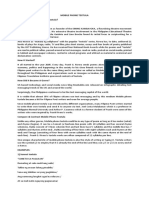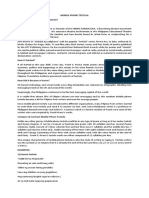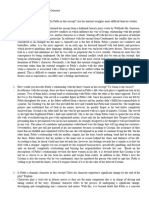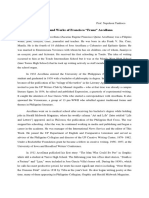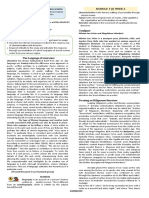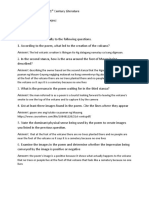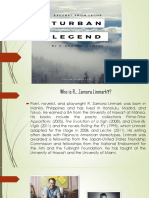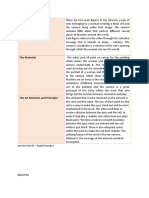Textula
Textula
Uploaded by
jho_olisCopyright:
Available Formats
Textula
Textula
Uploaded by
jho_olisOriginal Title
Copyright
Available Formats
Share this document
Did you find this document useful?
Is this content inappropriate?
Copyright:
Available Formats
Textula
Textula
Uploaded by
jho_olisCopyright:
Available Formats
Electronic literature refers to works commonly published and shared on the Web.
Unlike traditional printed literature, it has features that could only be presented through
multimedia.
Kinds of Electronic Literature
Hyperpoetry This is a kind of graphic poetry, which combines words with
images. It has no standard lines or verses, but its words are arranged in a way that
it creates meaning and visual effect.
Hyperfiction This contains hyperlinks. When readers click on a hyperlink, they
go to another Web page that contains the next part of a story.
Photo poem This uses real-life images or electronically generated images as
representation of the textual poem.
Silent comics These have no verbal dialogues. The dialogues are presented
through symbols.
Textula This poem is intended to be shared through the SMS.
Blog This Web site is where a person writes about his or her personal opinions,
activities, and experiences.
Frank Rivera
Frank Rivera, a playwright, received recognition for a number of his plays like Ambon,
Ulan, Baha: Sarsuwelang Pinoy (2003) and Oyayi, Ang Zarzuela (2004). Also, he received
awards for the Makata sa Cellphone (2005), a collection of poetry which includes his
popular textula. For his works of textula, he was dubbed as the makata sa cell phone.
Example:
A Textula (2013)
by Frank G. Rivera
Bayang mahilig sa ganda
Inuuna ang postura
Walang laman ang bituka
Kundi gasgas na pag-asa.
Si MEGAN YOUNG nang manalo
Nagbunyi ang Pilipino
May dala sanang asenso
Magkakapag-asa tayo.
Nagkagyera sa Mindanao
Kaban ng bayan ninakaw
Sa Bagyoy daming pumanaw
MISS WORLD, salamat sa araw.
(Reproduced by permission of Frank Rivera)
Explanation:
This textula has three stanzas, each of which has four lines. Each line has eight
syllables, which set a regular rhythm.
The poem uses what is called in Tagalog poetry as tugmang karaniwan, wherein
the last word of each line has the same sound. Also, the poem uses tugmang
patinig, wherein the last words of the lines have the same vowel sound, and
tugmang katinig, wherein the last words of the lines have the same consonant
sound.
Electronic literature refers to works commonly published and shared on the Web. Such
works have features that could only be presented through multimedia. Examples of
those works are hyperpoetry, hyperfiction, photo poems, silent comics, textula, and
blogs.
You might also like
- 7 Jamaica End of Year Examination.Document6 pages7 Jamaica End of Year Examination.Odayne Marshall100% (4)
- Korean Dramas:: Words & Phrases Every K-Drama Fan Should Know!Document14 pagesKorean Dramas:: Words & Phrases Every K-Drama Fan Should Know!Novia Dewi Ningsih100% (1)
- Feminist Jade FixedDocument1 pageFeminist Jade FixedKieth Garcia Daria0% (1)
- StonehengeDocument23 pagesStonehengeRhayan De CastroNo ratings yet
- Paolo ManaloDocument11 pagesPaolo ManaloIvy Mie Sagang43% (7)
- 100% Speaking & ListeningDocument205 pages100% Speaking & ListeningBongani Lungile Nameko100% (11)
- PTE Tips Consolidated Version - IndexedDocument44 pagesPTE Tips Consolidated Version - IndexedAdvikNagu0% (1)
- Mobile Phone TextulaDocument2 pagesMobile Phone TextulaRoxas Marry GraceNo ratings yet
- Mobile Phone TextulaDocument2 pagesMobile Phone TextulaRoxas Marry Grace0% (1)
- Hyper-Poetry and TextulaDocument6 pagesHyper-Poetry and TextulaSIEG The FREEDNo ratings yet
- 21st 1st Q REVIEWERDocument10 pages21st 1st Q REVIEWERHannah Jenne50% (2)
- Condemned ExcerptDocument2 pagesCondemned Excerptjessica clemente100% (1)
- Literature ArtistDocument4 pagesLiterature ArtistKrisha TubogNo ratings yet
- Examples of Imagery in LiteratureDocument3 pagesExamples of Imagery in LiteratureFJ Marzado Sta MariaNo ratings yet
- Word OriginDocument6 pagesWord OriginTeacher Mo67% (6)
- Lesson 13/ Poetry Memory of The Empire and in The Cosmopolitan Port CityDocument7 pagesLesson 13/ Poetry Memory of The Empire and in The Cosmopolitan Port CityJason B. Malone100% (1)
- Vibal - AN EARNEST PARABLEDocument2 pagesVibal - AN EARNEST PARABLEChelsey Lagasca Guasis67% (18)
- Literature Is She. LiteratureDocument4 pagesLiterature Is She. LiteratureMamerto LupoNo ratings yet
- History of Iloko LiteratureDocument5 pagesHistory of Iloko LiteratureLen Vicente - FerrerNo ratings yet
- 21st Century Q1 Module 1 Lesson 3 - CantreDocument2 pages21st Century Q1 Module 1 Lesson 3 - CantreJames Andrei CantreNo ratings yet
- Mayon by Kristian Sendon CorderoDocument14 pagesMayon by Kristian Sendon CorderoRegine Sama100% (1)
- 3 Philippine National Artists in LiteratureDocument14 pages3 Philippine National Artists in LiteratureMichelleIragAlmario50% (2)
- An Earnest ParableDocument20 pagesAn Earnest ParableFam Solomon100% (4)
- Written Report in EnglishDocument4 pagesWritten Report in EnglishCHINGCHONG SLAYERNo ratings yet
- Moonset at Central Park Station of STDocument1 pageMoonset at Central Park Station of STGeean75% (8)
- Module 3 Q1 Week 6: Spoken Language (Though It May Be Part of The Ploy), But AlsoDocument2 pagesModule 3 Q1 Week 6: Spoken Language (Though It May Be Part of The Ploy), But AlsoLawrence Sean MotinNo ratings yet
- Structural FunctionalismDocument21 pagesStructural FunctionalismJessebel Dano AnthonyNo ratings yet
- 21stCenturyLiteratureLesson1 LabiganLeidenDocument10 pages21stCenturyLiteratureLesson1 LabiganLeidenAnonymousNo ratings yet
- Rio AlmaDocument10 pagesRio AlmaSVÁNN YouTubeNo ratings yet
- Tagalog: para Abbing (Ibanag)Document3 pagesTagalog: para Abbing (Ibanag)Tricia FaithNo ratings yet
- 21 Century Literature Quarter 1-Module 2: The Literary Genres: Poetry and FictionDocument25 pages21 Century Literature Quarter 1-Module 2: The Literary Genres: Poetry and FictionKarla CarbonelNo ratings yet
- An Open Letter To Filipino ArtistsDocument2 pagesAn Open Letter To Filipino Artistswho disNo ratings yet
- Literature Lesson 2 ActivityDocument6 pagesLiterature Lesson 2 ActivityDenver CorpuzNo ratings yet
- 21st Century Literature by Isagani R.docx SssssDocument4 pages21st Century Literature by Isagani R.docx SssssClaire Ann GarbosaNo ratings yet
- 21st Century Lit ReviewerDocument26 pages21st Century Lit ReviewerRenz RamosNo ratings yet
- Unit I-21 Literature in Various RegionsDocument114 pagesUnit I-21 Literature in Various RegionsVilmalyn100% (2)
- Questions-21st Century Literature From The Philippines and The World Mobile HUMSSSTEMABM-Default For 21st Century Literature From The Philippines and The World-20201126-1322Document30 pagesQuestions-21st Century Literature From The Philippines and The World Mobile HUMSSSTEMABM-Default For 21st Century Literature From The Philippines and The World-20201126-1322Mark PadernalNo ratings yet
- 21St Century Literature Genre: Miss Paulene Galimba GacusanDocument43 pages21St Century Literature Genre: Miss Paulene Galimba GacusanKarla Bernadette Honrado100% (2)
- CORE 21st Century Literature Module 11Document4 pagesCORE 21st Century Literature Module 11Kyla Orantia0% (1)
- Lesson 6 Magdalena JalandoniDocument2 pagesLesson 6 Magdalena JalandoniJared Darren S. OngNo ratings yet
- Bicol and Pampanga LiteratureDocument3 pagesBicol and Pampanga LiteratureMichelle GoNo ratings yet
- 21st Century Literature q1 Module 2Document27 pages21st Century Literature q1 Module 2Raymart DiaperaNo ratings yet
- The Love of Magdalena JalandoniDocument13 pagesThe Love of Magdalena JalandoniRhayan De Castro100% (1)
- Gabriel Garcia Marquez: Louie Jon A. SanchezDocument12 pagesGabriel Garcia Marquez: Louie Jon A. Sanchez이한글No ratings yet
- Turban LegendDocument16 pagesTurban LegendKanor Dalisay100% (1)
- Poem AnalysisDocument2 pagesPoem AnalysisDailyn VergaraNo ratings yet
- Literary Appreciation Skills and Reading Performance of University StudentsDocument28 pagesLiterary Appreciation Skills and Reading Performance of University StudentsGlenda PalerNo ratings yet
- The Popularity of Wattpad As A Reading App Among Senior High School StudentsDocument32 pagesThe Popularity of Wattpad As A Reading App Among Senior High School StudentsCathlene EdemNo ratings yet
- Kiss by CarlosDocument1 pageKiss by CarlosRhea PatacsilNo ratings yet
- Banana Heart SummerDocument18 pagesBanana Heart Summercrys naresNo ratings yet
- Voice Tape Reflective EssayDocument4 pagesVoice Tape Reflective EssayReign Cuyos67% (3)
- 21st Century Literature FINALSDocument8 pages21st Century Literature FINALStinNo ratings yet
- The Subject Matter: See The World - Radel ParedesDocument2 pagesThe Subject Matter: See The World - Radel ParedesEnya NequingNo ratings yet
- Lesson 1 21st Century LitDocument24 pagesLesson 1 21st Century Litmark padernal100% (1)
- 21st CENTURY LITERATURE - Q2 SUMMATIVE 1Document4 pages21st CENTURY LITERATURE - Q2 SUMMATIVE 1Dave Sulam0% (1)
- 21st Century Rethinking The Tower of BabelDocument2 pages21st Century Rethinking The Tower of Babelbea locsin100% (2)
- Critical Reading Strategies in LiteratureDocument14 pagesCritical Reading Strategies in LiteratureValerie Cruz - Ocampo100% (1)
- A Critique On Romeo & JulietDocument8 pagesA Critique On Romeo & JulietRoceljean MarfeNo ratings yet
- The American PeriodDocument12 pagesThe American PeriodRustan Andrei DumlaoNo ratings yet
- EssayDocument1 pageEssayAli100% (2)
- Voice Tape PDFDocument14 pagesVoice Tape PDFAngeline Limbaga Trayfalgar75% (4)
- Communicative StrategiesDocument23 pagesCommunicative Strategiesjho_olis68% (25)
- Mapeh 6: Graphical Representation of The Results of The First Summative TestDocument3 pagesMapeh 6: Graphical Representation of The Results of The First Summative Testjho_olisNo ratings yet
- DisgruntledDocument1 pageDisgruntledjho_olisNo ratings yet
- Writing An Application Letter For College AdmissionDocument19 pagesWriting An Application Letter For College Admissionjho_olis100% (4)
- Transitional WordsDocument38 pagesTransitional Wordsjho_olis67% (3)
- Text As Connected DiscourseDocument17 pagesText As Connected Discoursejho_olis90% (10)
- Quiz - Claims AssertionsDocument1 pageQuiz - Claims Assertionsjho_olis43% (7)
- EClinic - Phonetic Symbols PDFDocument2 pagesEClinic - Phonetic Symbols PDFjho_olis0% (1)
- Patterns of DevelopmentDocument5 pagesPatterns of Developmentjho_olisNo ratings yet
- MECHANICS and ORTHOGRAPHYDocument31 pagesMECHANICS and ORTHOGRAPHYjho_olisNo ratings yet
- BrainstormingDocument19 pagesBrainstormingjho_olisNo ratings yet
- Making An Outline: A Plan That Builds An EssayDocument17 pagesMaking An Outline: A Plan That Builds An Essayjho_olisNo ratings yet
- Figures of OmissionDocument9 pagesFigures of Omissionjho_olisNo ratings yet
- Figures of RepetitionDocument4 pagesFigures of Repetitionjho_olisNo ratings yet
- Main Idea Activity 11Document13 pagesMain Idea Activity 11jho_olisNo ratings yet
- 4 Jane K Lartec Et Al PDFDocument16 pages4 Jane K Lartec Et Al PDFjho_olisNo ratings yet
- Senior High School Student Council Certificate of Candidacy: 2'' X 2'' PictureDocument2 pagesSenior High School Student Council Certificate of Candidacy: 2'' X 2'' Picturejho_olisNo ratings yet
- A Feminist Analysis of Patriarchal Oppression of Women in The NovelDocument5 pagesA Feminist Analysis of Patriarchal Oppression of Women in The Noveljho_olisNo ratings yet
- Functions of CommunicationDocument22 pagesFunctions of Communicationjho_olisNo ratings yet
- Types of SpeechesDocument9 pagesTypes of Speechesjho_olisNo ratings yet
- 01 Fundamental Considerations On Text Production and Consumption - Venndaigram.lenina Raiza C. SalvoroDocument2 pages01 Fundamental Considerations On Text Production and Consumption - Venndaigram.lenina Raiza C. SalvoroLenisiee0% (1)
- 02options4 M3 ExtraPractice SectionBDocument2 pages02options4 M3 ExtraPractice SectionBLaura CarniceroNo ratings yet
- Future Going To Study GuideDocument24 pagesFuture Going To Study Guidelaualvanez0.1No ratings yet
- English Cala Name: Lubelihle N. Mabhena School: Khumalo Primary School Level: Grade 7 Topic: Punctuation Marks Duration: 2 Weeks Component: ADocument14 pagesEnglish Cala Name: Lubelihle N. Mabhena School: Khumalo Primary School Level: Grade 7 Topic: Punctuation Marks Duration: 2 Weeks Component: AFiona ChitenderuNo ratings yet
- Anh 6 - de Cuong HK1 - 23-24 - c2TCDocument5 pagesAnh 6 - de Cuong HK1 - 23-24 - c2TCThư AnhNo ratings yet
- Enga10 Unit2 Test1Document6 pagesEnga10 Unit2 Test1Margarida FerreiraNo ratings yet
- Basic Writing Skill Module!!Document62 pagesBasic Writing Skill Module!!Man SanchoNo ratings yet
- Theory of GBA and Teaching SimulationsDocument10 pagesTheory of GBA and Teaching SimulationsPriya Darshini MuruganNo ratings yet
- Analisis Kebahasaan Teks EditorialDocument6 pagesAnalisis Kebahasaan Teks EditorialArfille PrasetyoNo ratings yet
- LING 3 MadaniDocument10 pagesLING 3 MadanidekhirNo ratings yet
- Materi Basic English Meeting 1Document15 pagesMateri Basic English Meeting 1Hamba AllahNo ratings yet
- Reported Speech - Unit 3 c1+Document5 pagesReported Speech - Unit 3 c1+Aitor Garcés-ManzaneraNo ratings yet
- дипломная работа - Даниярова - АРБDocument79 pagesдипломная работа - Даниярова - АРБSaikal DaniyarovaNo ratings yet
- Nicolls-A Grammar of The Samaritan Language-1838 PDFDocument152 pagesNicolls-A Grammar of The Samaritan Language-1838 PDFphilologusNo ratings yet
- The Literary Essay - ENG2DDocument22 pagesThe Literary Essay - ENG2DAlexandra JonesNo ratings yet
- Verbs Family ActivityDocument2 pagesVerbs Family Activityeng teaNo ratings yet
- Chapter 2 - Audience - LATEST PDFDocument42 pagesChapter 2 - Audience - LATEST PDFSt WxyNo ratings yet
- Using Comic Strip Stories To Teach Vocabulary in Intensive Reading ComprehensionDocument12 pagesUsing Comic Strip Stories To Teach Vocabulary in Intensive Reading ComprehensionSandy RodriguezNo ratings yet
- Esa+Inglês+ +ex.+ +Pronouns+IIDocument24 pagesEsa+Inglês+ +ex.+ +Pronouns+IIFelipe NascimentoNo ratings yet
- Phonics EFL Conference New GarethDocument41 pagesPhonics EFL Conference New GarethHaydee GonzalesNo ratings yet
- Fall LNG 241 SyllabusDocument5 pagesFall LNG 241 SyllabusniororoNo ratings yet
- A SyllogismDocument7 pagesA Syllogismkhatz91No ratings yet
- SimpleDocument2 pagesSimpleKku SouzaNo ratings yet
- Activities Guide and Evaluation Rubric - Unit 3 - Task 4 - Oral Production - Lets TalkDocument8 pagesActivities Guide and Evaluation Rubric - Unit 3 - Task 4 - Oral Production - Lets TalkAndrea prioloNo ratings yet
- Ivić, The System of Serbocroatian Cases Denoting Spatial RelationsDocument7 pagesIvić, The System of Serbocroatian Cases Denoting Spatial RelationsAntonio FilippinNo ratings yet
- English Test: 1. CompleteDocument11 pagesEnglish Test: 1. CompleteFrancisco Camilo Hernandez MurgaNo ratings yet







